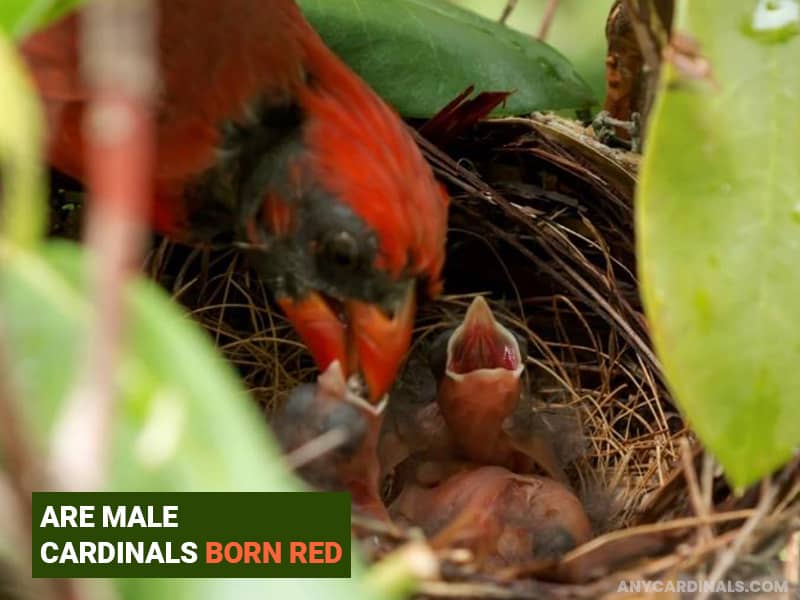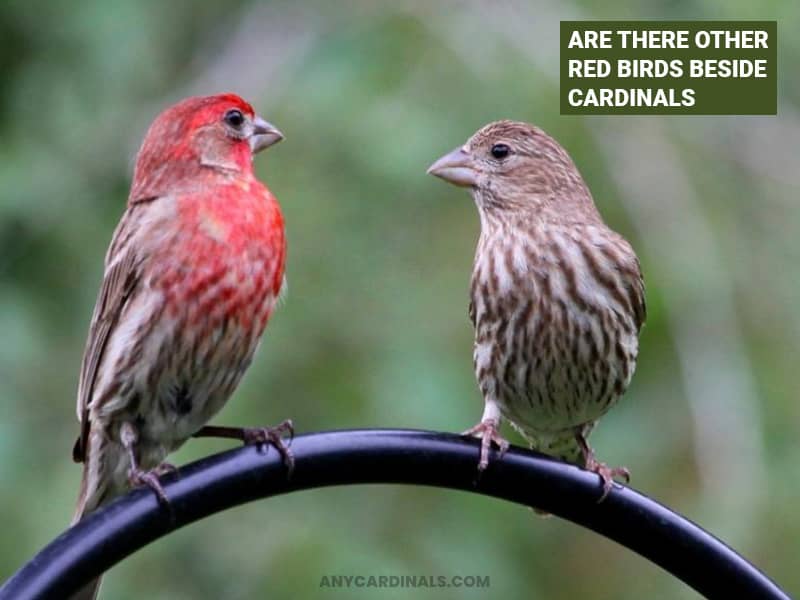Are All Red Cardinals Male?
Northern cardinals always draw most people’s attention with their brightly colored red plumage. Mostly, this type of feather is seen in male cardinals. So, does that mean only male cardinals have red feathers! Or are all red cardinals male?
Yes, all-male cardinals are red. They come with a black face and a reddish bill. Unlike them, female cardinals have a pale brown plumage. But similarly, females also boast a black face and red-orange bill.
That said, let’s now explore all the facts regarding the male cardinals’ red plumage in this content. Let’s get started.
Check out these related blogs:
Why Are Male Cardinals Red?
Cardinals tend to eat seeds and fruits, from which they get pigment molecules known as yellow carotenoids.

Later these birds convert these yellow pigments from yellow to red and transfer them to their feather-growing cells. Consequently, they achieve red plumage.
Benefits Male Cardinals Get By Being Red:
According to a study, red male cardinals get various benefits due to having a red plumage. Below, we have described what facilities they get.
01. They Can Easily Attract Mates:
Male cardinals are polygamous, meaning they will mate with several females during the breeding season. And to attract mates, male cardinals need to be highly visible.
Their red plumage makes them stand out in their habitats, which gives them a better chance of being seen by potential mates.
02. They Remain Less Noticeable To Predators:
Being red also has its benefits when it comes to fighting off predators. Studies have shown that predators are more likely to attack yellow and green birds than red ones.
So being red gives male cardinals a better chance of finding mates and surviving predators.
Why Do Male Cardinals Lose Their Red Color?
Like other birdies, cardinals also molt their feathers in fall and grow new plumage in late summer. After breeding season and during the molting period, they face food scarcity, due to which their feathers look duller red color.

However, sometimes male cardinals will lose their red color. This can be due to a number of reasons, including stress, illness, or a lack of carotenoids in their diet.
Are Cardinals Only Red?
No, cardinals are available in yellow, white, and golden brown colors apart from red. Some people believe a phenomenon of blue cardinals’ existence; in reality, they are nowhere.
Their primary colors are red for males and grey-brown for female cardinals.
Are Male Cardinals Born Red?
No, cardinals aren’t born red; neither is red their mainstream color.
In general, both males and females have pink skin and gray scales. With time and through molting, they develop red and other colored plumage.

So, the next time you see a male cardinal, remember that its beautiful red plumage is the result of a healthy diet!
Can Female Cardinals Be Red?
Female cardinals don’t come with the exact, brightest red-colored plumage as male cardinals. But they contain drearily dull, reddish-colored feathers, which look more like a bit brown.
Female cardinals also boast tan colors on their back, breast, and sides. And also, they have red-orange colored wings, bill, crest, tail, and crown.
Why Are Female Cardinals Not Red?
Female cardinals don’t have as bright red plumage as males because their feathers don’t contain the same amount of red pigment.

It’s also conceivable that the distinct hues of male and female cardinals result from sexual selection.
Do Cardinals Get Redder In Winter?
Although cardinals do not actually change their plumage in winter, they may seem redder during this time. The possible reason for that can be the light reflecting from their feathers, creating an illusion that they are redder.

During winter, the sunlight needs to travel a longer distance through the atmosphere to reach Earth. And this long journey filters out some of the blue and violet wavelengths of light, leaving only the warmer oranges and reds.
Hence, when sunlight hits a cardinal’s feathers, the bird appears comparatively redder in winter than it appears in summer.
Are Red Birds And Cardinals Same?
No, red birds and cardinals aren’t the same. Cardinals are a type of red bird, but there are many other types of red birds. So you need to understand while all male cardinals are red birds, not all red birds are cardinals.

One key difference between these two groups is that cardinals are seed-eating birds, while many other red birds primarily eat insects. Cardinals also have a crown on their head, whereas most red birds do not.
Thus, despite their similarities, red birds and cardinals have several crucial differences.
Are There Other Red Birds Beside Cardinals?
Yes, you can find several red birds besides cardinals. Some examples of other red birds include:

- Red crossbills
- Red-breasted nuthatches
- House finches
- Painted buntings, etc.
However, not all red birds come with the same bright red colored plumage. For instance, the scarlet tanager is a colorful red bird, while the female house finch is duller red.
FAQ’S:
01. What Does It Mean When You See A Red Cardinal?
Some people relate this fact with spirituality, while others consider cardinals symbols of strength, vitality, and promise. A few people also believe that seeing cardinals means their family or friends are safe. Hence, the meanings are distinct.
02. Do Cardinals Get Redder With Age?
No, adult cardinals do not get redder with age. But younger cardinals do. Their plumage slowly turns red, and their black beak turns a deep reddish color.
03. What Makes Some Cardinals Redder?
Carotenoids, found in many seeds, fruits, and vegetables, help cardinals develop red-colored plumage.
To Finish Up:
Northern red male cardinals are one of Mother Nature’s astounding wonders that will always impress you with their outlook and personality traits. Their activities will quench your thirst for curiosity, while their vibrant red feathers will soothe your peepers. Hence, you should keep all the arrangements for them to make them visit your yard again and again.
That’s all for this content; we hope we have provided the required information you were searching vigorously on the internet. If you found this article promising, we will be glad to have you as our followers on Facebook, Twitter & Pinterest.

